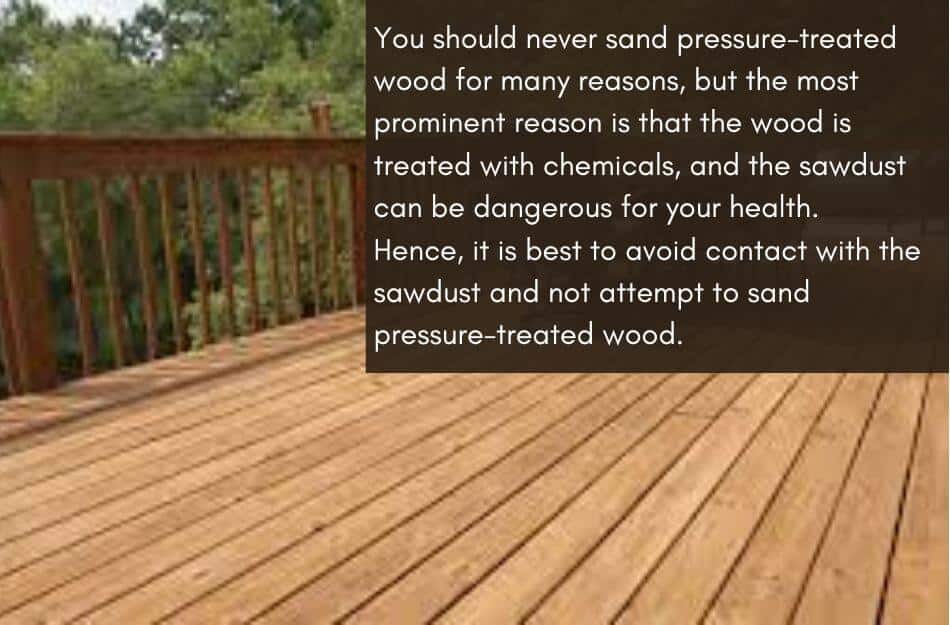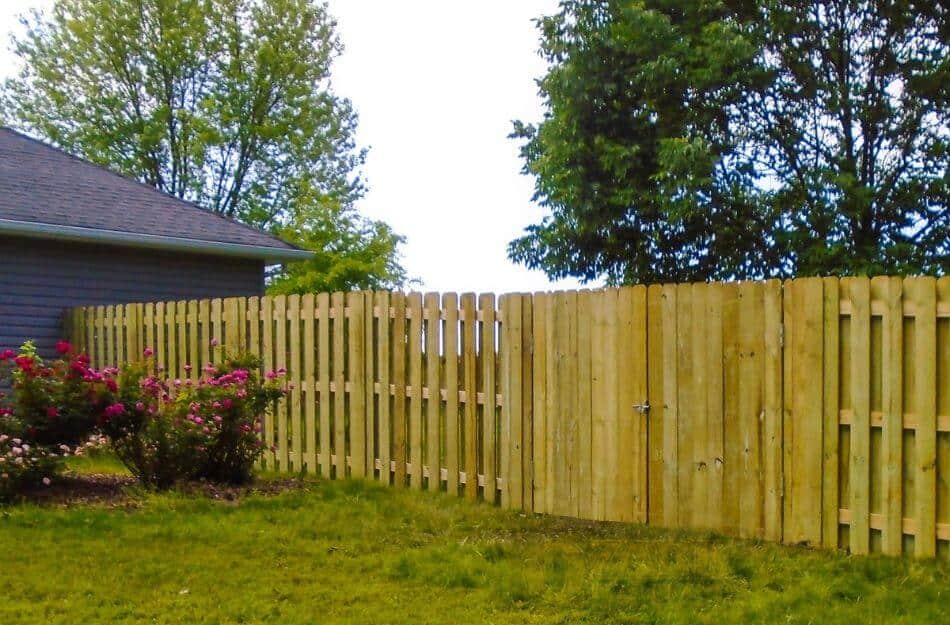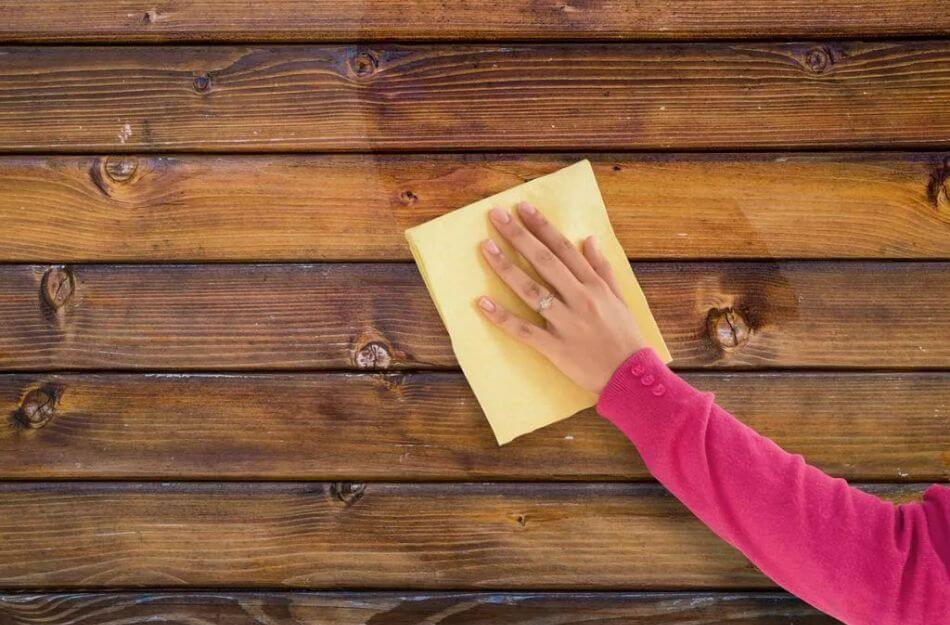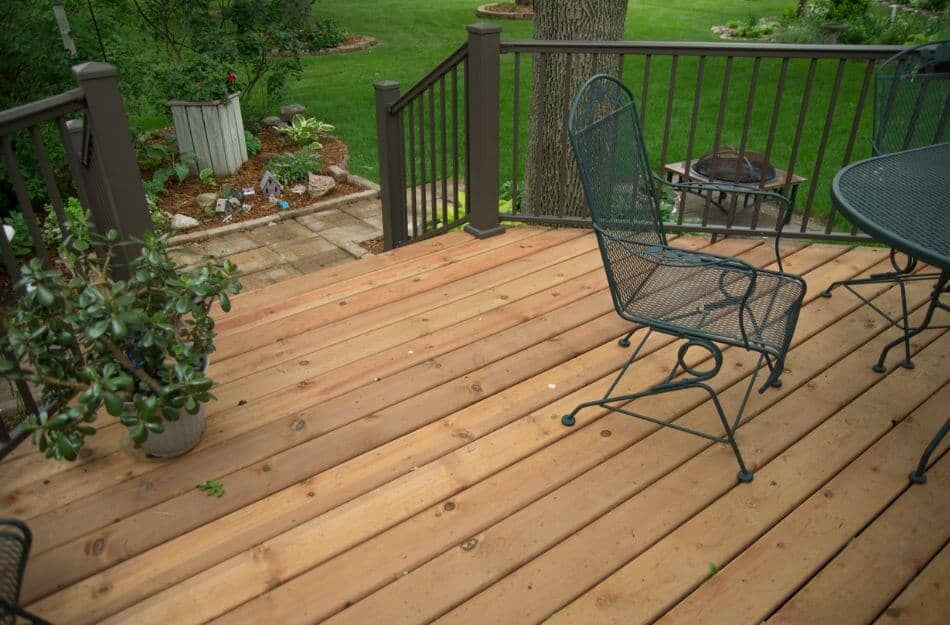If you’ve got pressure-treated wood, you likely need to learn how to treat it correctly. Many people confuse pressure-treated wood with normal wood and use it similarly.
A common mistake is to sand pressure-treated wood; if you’re wondering how that is a mistake, keep reading, and you’ll find out.
You should never sand pressure-treated wood for many reasons, but the most prominent reason is that the wood is treated with chemicals, and the sawdust can be dangerous for your health.
Hence, it is best to avoid contact with the sawdust and not attempt to sand pressure-treated wood.

Table of Contents
Disadvantages of Sanding Pressure Treated Wood
Sanding down pressure-treated wood is more harmful than you might think.
Not only is it injurious to your health, but it can also deteriorate the condition of your wooden boards depending on the types of chemicals used and the time from manufacturing.
There is nothing to gain from sanding down pressure-treated wood as it is already fine enough. However, if you still want to consider this option, you must be aware of what the outcomes can be.
Below are some of the potential dangers and disadvantages that come from sanding down pressure-treated wood.
Also Read: Best Decking Material For Winter: Find Your Best Option
You May Spoil The Surface
Sanding can have many adverse effects on pressure-treated lumber, including surface spoiling. The grain of the wood is destroyed, and the appearance is nowhere near presentable.

Besides, the worst factor is that you can never predict when and how badly it is going to spoil the wood. The results of sanding can be shown slowly.
You might start to see deformity in the grain of your wood after some time, and it is impossible to predict how much deformity you might see.
Hence, if you want to save the grain and texture of your pressure-treated wood, it is best that you let it as it is and do not attempt sanding.
See Also: Deck Landscaping Ideas With Rocks: Creative Outdoor Space
Variable Quality
There are tons of brands in the market that sell pressure-treated wood, and all of them market themselves as the best. However, we all know that quality varieties exist even in pressure-treated lumber.
This variety of quality can bring out unpredictable results after sanding.
It doesn’t matter if you have bought the most expensive or the best quality PT wood; it is still as unpredictable as the cheapest one. Pressure-treated wood is inconsistent and unpredictable. This means you can’t be sure if the good quality lumber will get spoiled or bad.
Besides, the extent of the spoilage is also unpredictable in terms of time, quality, and severity. Hence, it is best to refrain from sanding down on your wooden pressure-treated boards.
Dangerous For Health
Pressure-treated wood is treated with chemicals to make it strong and resistant to infestations, moisture, scratches, and weather. Sanding it down can release chemicals like the smell or even sawdust.

Even if you are not a chemist, you will understand that inhaling or getting into direct contact with chemicals is not desirable.
Whether you wear a mask or not, your health is still at risk if you’re exposed to the chemicals; if not for something else, the chemicals can hurt your eyes too.
It is best to leave it be and not sand any type of pressure-treated lumber.
Don’t Miss: How Long Should You Wait Before Painting A New Deck?
Irreversible
The change is irreversible, and your wooden boards will never return to how they used to look earlier. If the surface is destroyed once, it can never return to being smooth again as it was.
Besides, if you like the black finish of pressure-treated lumber, you must know that you will only be left with a blue or greenish hue after you’ve sanded the wood.
This way, you will lose the seamless appearance and look that the wood once had, which can never be restored.
No Suitable Outcome
From all the discussion above, it can be derived that sanding pressure-treated wood has no practical use and only leads to possibilities of damage and destruction to the wood’s surface.
Hence, taking such a big risk and potentially getting your wood spoiled forever is not worth it.
How To Sand Pressure Treated Wood Safely?
The safest way to sand down pressure-treated wood is to wait for the chemicals to settle in and wear all the safety equipment before you attempt to sand it.

Although it is not recommended, if you are still persistent about sanding down pressure-treated wood, you must do it safely and carefully.
Wait For The Chemicals To Settle
If you attempt to sand the wood as soon as it is bought, you might be exposed to chemicals. Hence, it is best that you allow the wood to settle in and let the excess moisture out. The average time for this is around 6 to 8 months.
Sanding pressure-treated wood too early would also mean that the smooth texture is now destroyed, which will encourage the wood fibers to stand up occasionally and give you slivers either while walking barefoot or cleaning.
Certain factors determine when the wood is ready to be sanded:
Wood Type: The type of wood used in building your deck plays a huge role in determining the time it would need before all the chemicals have settled in.
Pressure Treated Lumber is treated with pressure to make it robust and resistant to the actions of wind and rain. The optimum time is around 6 months; however, it is best to test the wood for moisture before painting it.
Climate: The climate of the area and the current weather are also major factors in determining how much time the wood will require.
If you live in a colder environment, you might experience delays in drying as the humidity level is already high, and temperature levels need to be better to allow moisture to evaporate.
However, if you live in a hotter climate. You might see a quicker response as the heat would allow for better evaporation, and the chemicals would settle in faster.
Types of Chemicals: The chemicals used in treatments play a major role in deciding when they need to settle in.
Hence, the treatment type is a useful indicator to identify which chemicals have been used, their purpose, and how much time will be required to let them settle in.
You can find this either in the user manual or by contacting the manufacturer. Once you know all the necessary details, you can start sanding your deck at the right time.
How To Know If The Chemicals Have Settled In?
Although it is near impossible to know whether the chemicals have completely settled in, you can get a decent idea by using a precipitation meter. If the moisture level is below 15%, you can sand the deck now.

You can also use a manual method to spill some water onto the wooden surface. If the water beads up, the wood isn’t ready.
However, you can sand your deck now if the water gets soaked as the excess moisture has dried out, which means the chemicals have probably settled in.
Furthermore, it is important to carry out these tests in several places on the deck, as there are chances that some areas have dried up before others, meaning that the chemicals have not evenly settled and can still threaten your health.
Use Protective Gear
Once you have checked all the necessary factors and think that the wood is ready to be sanded, you must wear protective gear before starting the process.
- Gloves: Gloves are important to protect the skin on your hands from any possible damage caused by contact with the chemicals. Although it is best to get industrial-grade gloves, if you don’t find them, try to wear the thickest gloves you have.
- Full Sleeves: You must wear a full sleeve shirt to protect the skin on your wrists and your arms. It is not wide to expose skin while working with chemicals.
- Boots: Although it might look like a home project, you must not take it lightly and attempt to sand your wooden floors in flip-flops. As mentioned earlier, cover as much skin as possible.
- Eye Glasses: Protecting your eyes is crucial to complete the sanding process seamlessly. The chemicals and the sawdust can hurt your eyes if not covered well, leading to infections requiring medical attention.
- Respiratory Mask: The most concerning factor is that you must not inhale the smell or the sawdust while attempting to sand the pressure-treated wood. Wearing a normal face mask is ineffective, so avoid making this mistake. It is compulsory to wear a respiratory mask to prevent any chemical particles from entering your respiratory system.
Takeaway
There are better ideas than sanding down pressure-treated wood if you want to treat the wood right.
Not only does it pose potential risks to your health, but the surface of the wood can also be ruined in this attempt. Hence, avoid this decision and try working with the beautiful surface you have.
However, if you still insist on sanding, ensure you do it correctly in a safe and controlled environment.
Recent Posts
Although deck sealing may not be at the top of your summer to-do list, you shouldn’t put off a task.One such deck that channels the opposite of the lively and enjoyable vibe you want from an...
Any home would benefit from having a deck because it adds more area for socializing, relaxing, and outside activities.Garden decking that has been properly polished can be elegant and lovely. It...
